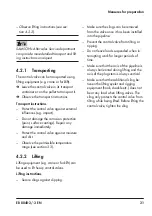
34
EB 8048-2/-3 EN
Servicing
7
Servicing
The control valve is subject to normal wear,
especially at the diaphragm, seat, plug, and
packing. Depending on the operating condi-
tions, check the valve at regular intervals to
prevent possible failure before it can occur.
SAMSON's After‑sales Service department
can support you to draw up an inspection
plan for your plant.
Risk of bursting in pressure equipment.
Control valves and pipelines are pressure
equipment. Improper opening can lead to
valve components bursting.
−
Before starting any work on the control
valve, depressurize all plant sections con
-
cerned as well as the valve.
−
Drain the process medium from all the
plant sections concerned as well as the
valve.
−
Wear personal protective equipment.
Risk of personal injury due to residual pro
-
cess medium in the valve.
While working on the valve, residual process
medium can escape and, depending on its
properties, may lead to personal injury, e.g.
(chemical) burns.
Wear protective clothing, safety gloves, and
eyewear.
Risk of burn injuries due to hot or cold com
-
ponents and pipeline.
Valve components and the pipeline may be
-
come very hot or cold. Risk of burn injuries.
−
Allow components and pipelines to cool
down or heat up.
−
Wear protective clothing and safety gloves.
Risk of valve damage due to incorrect
servicing or repair.
Service and repair work must only be
performed by trained staff.
Risk of valve damage due to excessively high
or low tightening torques.
Observe the specified torques on tightening
control valve components. Excessively tight
-
ened torques lead to parts wearing out
quicker. Parts that are too loose may cause
leakage.
Observe the specified tightening torques
(
u
Risk of valve damage due to the use of un
-
suitable tools.
Only use tools approved by SAMSON
(
u
Tip
DANGER
!
WARNING
!
WARNING
!
NOTICE
!
NOTICE
!
NOTICE
!
















































